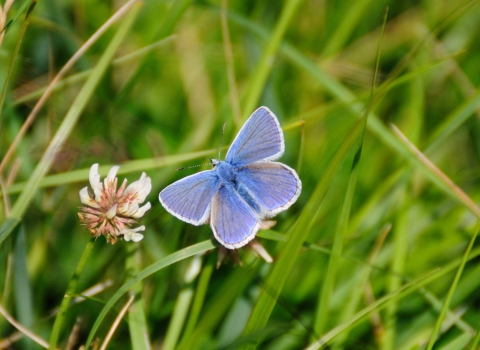South Pennines Grasslands Project
Restoring, reviving and reconnecting species-rich grassland in the South Pennines
The South Pennines Grasslands Project was a five-year project which ran from 2014 – 2019. Funded by WREN, a landfill community fund, with third party contribution provided by the Scout Moor Habitat Enhancement Fund, this exciting initiative aimed to not only create new areas of species-rich grassland in the South Pennines and West Pennine Moors, but restore and improve existing areas of degraded grassland.
The South Pennines Grasslands Project had three main goals:
1. To restore, improve and bring into positive management 200ha of species-rich grassland
We worked with landowners to bring grasslands into positive management by providing advice, support and funding capital works on the ground. Typical practical works to restore grasslands included:
- Restoration cuts
- Scrub control/removal
- Species diversification by scarifying and seeding
- Field boundary installation/restoration
- Providing livestock-handling infrastructure
- Access improvements to enable or facilitate management
2. To create 50ha of new species-rich grassland
We created these new sites in places that would join up as many existing habitats as possible, helping to form a Nature Recovery Network of grasslands that wildlife can move between. We seeded them:
- In adjacent fields
- In sites within a grassland corridor and/or on sites that will function as stepping stones between existing grasslands
- Using green hay from Local Wildlife Sites where possible, otherwise using a suitable wildflower seed mix
3. To raise awareness of the presence and importance of species-rich grassland in the South Pennines
Sir David Attenborough is right when he says that, “No-one will protect what they don't care about, and no one will care about what they have never experienced.” Many people are so used to seeing sterile fields that they simply aren't aware that species-rich grassland exists, or just how important it is. We countered this by:
- Promoting a programme of events linked to the delivery of works on the ground
- Delivered grassland education and interpretation
- Involved volunteers in our work
- Collected evidence to demonstrate the impact of the works and enhancement of the grassland network
By working together with the local community and inspiring people to care for these precious wild places, as well as actively preserving them, we hoped to improve the fortunes of the (sometimes rare) flora, fauna and fungi that call them home and safeguard our local grasslands into the future.
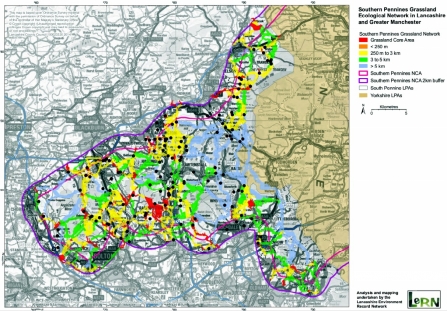
What did we achieve?
Why is species-rich grassland so important?
Species-rich grassland brims with life, supporting wildflowers, fungi, bees, flies, beetles, spiders, moths, butterflies, reptiles, amphibians, small mammals, bats and birds. Much of this wildlife is in decline and can even be incredibly rare - it needs healthy hay meadows, unimproved pasture and other flourishing grassland refuges in order to thrive.
Sadly, 97% of species-rich grassland in the UK has been lost since 1945.
These vital sanctuaries now cover less than 1% of our country, and the wildlife that depended on them is feeling the devastating loss:
- Two bumblebee species have been driven to extinction in the UK during the 20th century
- Six bumblebee species are BAP (Biodiversity Action Plan)-listed as priority species and are teetering on the brink
- Specialist grassland butterflies such as the large skipper, common blue, small copper and meadow brown are now highly localised; confined to pockets that haven't yet experienced the drastic decline in the wildflowers their caterpillars depend on
- Birds like twite and skylarks that depend on hay meadows to raise their young have plummeted in numbers
- One in five native wildflower species face extinction
We, too, face our own threats triggered by the loss of species-rich grassland. Wildlife-rich landscapes are crucial for our wellbeing, certain grassland soils lock up carbon and floodplain meadows hold back flood waters. What's more, more healthy grasslands mean more of the pollinators and natural pest controllers our agricultural crops depend on.
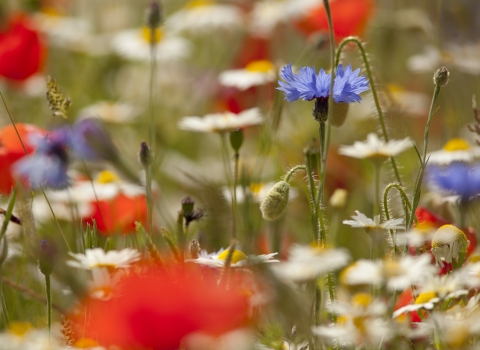
What happened to our meadows?
The advent of industrialised agriculture during the mid-20th century dramatically boosted the productivity of farmland across the UK. The cost of high yield, intensive agriculture has seen the widespread loss of wildlife and wildflower-rich habitats historically associated with traditionally-managed farmland.
Species-rich grassland, and the biodiversity it supports, represents perhaps the greatest ecological casualty of intensive agricultural practices.
Unimproved hay meadow is classified as species-rich grassland which has traditionally been managed under a low nutrient regime. Classically, a hay cut is taken in late summer and/or low intensity grazing applied.
Rich floral communities evolve under traditional grassland management. By contrast, agriculturally-improved grassland has sacrificed wildflower communities (through ploughing, re-seeding and soil nutrient enrichment) in favour of lush grass growth to support silage production or intensive grazing.
Unimproved grasslands continue to be viewed as unproductive under conventional agricultural expectations. The major threats which continue to face unimproved, species-rich meadows include agricultural intensification, changes in land use, neglect (leading to coarse grass, scrub, and woodland succession), and floristic impoverishment through inappropriate management (e.g. overstocking or frequent cutting).
Wildflower meadows are vital habitats for birds, butterflies, bees and other wildlife. It is crucial that action is taken to restore these endangered habitats and create new species-rich grasslands.
Senior Conservation Officer
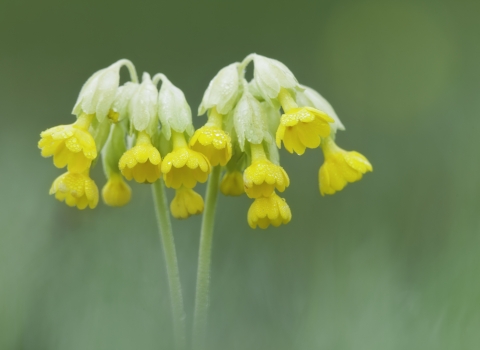
Work with us to manage your land
Do you own land on a Biological Heritage Site, a Local Wildlife Site, or a Site of Biological Interest? Does your land contain large numbers of wildflower species, or would you like to create a species-rich meadow on your land? We'd love to help you.
Our passionate conservation experts have a wealth of knowledge to share and can help you transform your land into a refuge for wildlife.

Jon Hawkins - Surrey Hills Photography
Get your local council involved
Almost all council parkland and green space is mown every two weeks throughout the summer months, preventing the growth of the diversity of wildflowers that could potentially be feeding pollinators and making our hearts sing.
Not all of this grassland is used for sports and picnics, and these unused areas could be left uncut for both nature and people, with the grass removed at the end of summer. A simple change in the mowing regime can have big effects on the numbers of grass and wildflower species, and in turn, the numbers of birds, bees and butterflies in your local green spaces.
Why not ask your local council to leave some areas to grow wild?

Kieron Huston
Create a wildflower meadow at home
If you have a large area of lawn in your garden, why not turn part of it into a wildflower meadow? It's likely there are already wildflowers lying dormant and just waiting for their moment to burst forth - it's amazing what can pop up just by retiring the mower until the end of summer.
If you only have a small garden without any areas of grass, why not plant some pollinator pots instead? Lavender, foxgloves, heathers, and herbs like sage and oregano are great nectar-rich options. You could even create some raised beds.
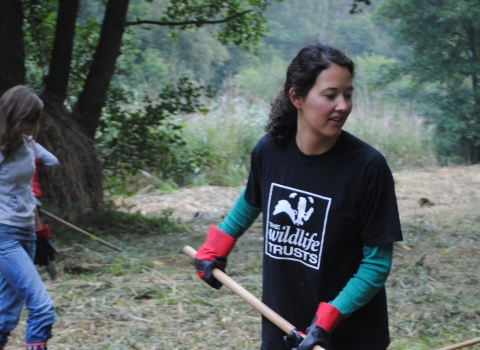
Volunteer with us
We manage more than 40 nature reserves and countless Local Wildlife Sites, many of which include wildflower meadows. If you'd like to help us conserve them and improve the fortunes of wildlife across our region, why not volunteer with us?
Contact Us
For more information on this project please contact the Project Officer, John Lamb.
T: 01772 317240
E: jlamb@lancswt.org.uk

Funders & Partners
The South Pennines Grassland Project is funded by WREN.
Partners in the project include:
Natural England, South Pennines Local Nature Partnership, Pennine Prospects, LERN, GMEU, Lancashire County Council, Borough Councils in the Lancashire and Greater Manchester South Pennines NCA.


